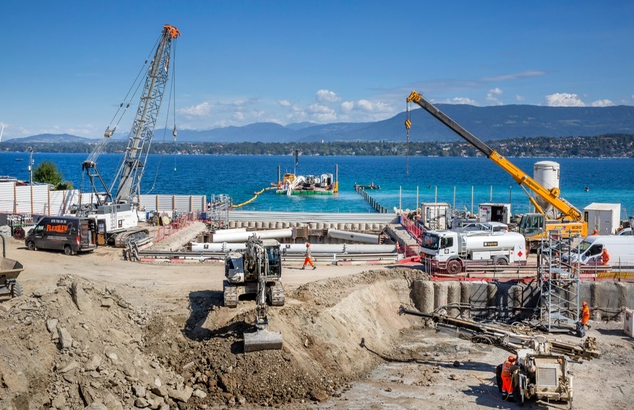A CHF800 million (5 million) new pumping station is under construction north of Geneva as part of the Genilac project. Swiss lakes offer huge potential as renewable energy sources that can be used to cool and heat buildings. Geneva is expanding a pioneering thermal exchange project to help meet its climate goals, while other regions are taking the plunge. After transport, the second and third biggest sources of national greenhouse gas emissions are Swiss industry (20% of total in 2017) and households (18%). In Geneva, buildings occupied by firms and residents account for half of local CO2 emissions. The Geneva authorities, businesses and institutions keen to reduce their dependence on fossil fuels are therefore seeking new ways of saving energy. Just north of
Topics:
Swissinfo considers the following as important: 3) Swiss Markets and News, 3.) Swiss Info, Business, Climate challenge, environment, Featured, International Geneva, newsletter, Sci & Tech, Sci & Tech
This could be interesting, too:
RIA Team writes The Importance of Emergency Funds in Retirement Planning
Nachrichten Ticker - www.finanzen.ch writes Gesetzesvorschlag in Arizona: Wird Bitcoin bald zur Staatsreserve?
Nachrichten Ticker - www.finanzen.ch writes So bewegen sich Bitcoin & Co. heute
Nachrichten Ticker - www.finanzen.ch writes Aktueller Marktbericht zu Bitcoin & Co.

A CHF800 million ($805 million) new pumping station is under construction north of Geneva as part of the Genilac project.
Swiss lakes offer huge potential as renewable energy sources that can be used to cool and heat buildings. Geneva is expanding a pioneering thermal exchange project to help meet its climate goals, while other regions are taking the plunge.
After transport, the second and third biggest sources of national greenhouse gas emissions are Swiss industry (20% of total in 2017) and households (18%). In Geneva, buildings occupied by firms and residents account for half of local CO2 emissions. The Geneva authorities, businesses and institutions keen to reduce their dependence on fossil fuels are therefore seeking new ways of saving energy.
Just north of the city, the local power company, Services industriels de Genève (SIG),external link is expanding a thermal exchange network that uses water from the lake to cool and heat local buildings.
Launched ten years ago, the “Geneva-Lac-Nations” scheme currently serves the United Nations headquarters, the International Committee of the Red Cross, the UN Refugee Agency and the Biotech Campus.
The thermal exchange process is relatively simple. Millions of litres of water are pumped from 45 metres below the surface of Lake Geneva at a constant temperature of 6-10 degrees Celsius (43-50 degrees Fahrenheit) all year round. It is then piped inland and shared with the local network.
To cool buildings and computing facilities, it goes through a heat exchanger hooked up to the cooling system of the building. Heating is provided via modern heat pumps that produce hot water at 48C, eliminating the need for energy-intensive boilers, burners, chimneys and fuel tanks.
Owing to its success, SIG and the cantonal authorities are expanding the project, renamed “GeniLacexternal link”, aimed at helping to reduce fossil fuel consumption in Geneva by 39% by 2023.
Some 30km of water pipes will be laid, extending the network to the city centre, the airport, Grand-Saconnex, Bellevue, Pregny-Chambésy, the “Praille Acacias Vernets” district and the Geneva University Hospital. They will be connected to a CHF800 million ($805 million) new pumping station under construction, which should allow the canton to cut 70,000 metric tonnes of CO2 per year, or the equivalent released by 7,000 homes, by 2035.
When it is complete in 2035, Genilac will be the biggest thermal exchange network in Switzerland. But the idea of using natural water resources to heat and cool buildings is not new to the Alpine country.
In 1938, Zurich installed a heat pump in its cantonal parliament and used water from the nearby River Limmat. Today, the town of La Tour-de-Peilz, near Montreux, and the Federal Institute of Technology in Lausanne (EPFL) also use the pristine waters of Lake Geneva to heat and cool buildings. In Lucerne, the Bürgenstock Resort hotelexternal link uses a similar system to cover 100% of its heating and 80% of its cooling needs.
Other regions see the potential of lake water to reduce their carbon footprint. Canton St Gallen in northeastern Switzerland, for example, wants to reduce CO2 emissions from buildings by 20-30% by 2030.
It plans to replace fossil fuel heating systems with more environmentally friendly solutions. The cantonal authority believes that large lakes – Constance, Walenstadt and Zurich – represent an under-utilized source of energy and are reportedly offering support to local municipalities, energy suppliers, building owners and companies to come up with suitable projects.
In 2014, a study by the Swiss Federal Institute of Aquatic Science and Technology (Eawag)external link concluded that large, deep and temperate lakes offered “high potential” as heat sinks and sources. Lakes Geneva, Neuchâtel, Zurich, Lucerne, Constance and Thun could provide more than 60 gigawatts of usable heat, according to the lead author, Alfred Wüest.
The researchers said that drawing water from large lakes would have no ecological impact but warned this “might be different” for smaller and shallower bodies of water.
Tags: Business,Climate challenge,Environment,Featured,International Geneva,newsletter,Sci & Tech
